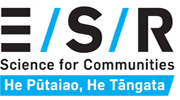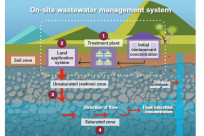ESR Senior Scientist Bronwyn Humphries and a team of microbiologists and environmental scientists work to understand how on-site wastewater systems impact groundwater.
The problem
Outside of reticulated wastewater areas, Aotearoa New Zealand relies on on-site wastewater management systems (OWMS), many of which were installed pre-2000, when resource consents were not required. While regional councils have information about consented OWMS since 2000, records for systems installed prior to this date often lack information about their location, type and/or condition. Anecdotal evidence suggests that systems are not adequately operated and maintained with wastewater removal companies reporting many failed systems around the country Management of these systems presents a challenge for both owners and regulatory bodies, and the risks from contamination can affect both environmental and human health.
In 2018, ESR led sampling from over 120 shallow wells around the country, and emerging organic contaminants (EOCs) where found in 70% of these sites. In fact, caffeine and sucralose EOCs were found upstream from centralised wastewater systems, suggesting on-site wastewater systems are ‘contributing’ these EOCs to groundwater.
Emerging Organic Contaminants
Emerging Organic Contaminants (EOCs) are like molecular ‘finger-prints’ of human activity. They are molecules that don’t occur in the environment naturally, so their presence can point to a source of contamination. Some of them are new contaminants recently introduced to products or medicines. Other EOCs may have been present as a contaminant for decades, but only recently detected or considered to be of a concern. Their impact on human, animal, and environmental health – as well as their presence in various environments – remains poorly understood. EOCs include preservatives, birth control hormones, caffeine, pharmaceuticals like paracetamol, plasticisers and many, many more.
Understanding how these on-site systems perform is important because of the downstream impacts on groundwater, which is where 40% of drinking water in Aotearoa New Zealand comes from. Bronwyn is leading a team to understand how these systems perform, with a specific focus on removal of microorganisms and viruses that cause human disease, and chemical contaminants such as nitrate.

The diagram above shows the opportunities for microbial and chemical removal in an on-site wastewater management system and the receiving environment: 1) the OWMS treatment plant, 2) land application system, 3) vadose zone (unsaturated zone) and 4) saturated zone.
The solution
Working with Environment Canterbury, Waimakariri Regional Council, ecoEng Ltd, Whiterock Consulting Ltd and with a system supplied by Hynds Wastewater, Bronwyn and her team are working at a domestic OWMS field research facility in rural Canterbury to investigate the impact of the system on groundwater quality. The research team has installed in-situ sampling points into the on-site system and 13 sampling wells located around and downstream of the wastewater land application system (LAS) – the ‘land disposal field’ of the OWMS.

Sampling an OWMS
Testing this system involves ‘dosing’ it with non-pathogenic versions of E.coli bacteria and viral indicator organisms, as well as chemical markers, and measuring how these tracers move through the LAS and into groundwater downstream. Preliminary results indicate that while bacteria were well filtered out by the LAS, the viral and chemical tracers were detected two metres downgradient in the groundwater within two hours.
The research team is now investigating the contribution of on-site systems to nitrogen in groundwater, as well as the fate and transport of pathogen surrogates used as tracers. In addition to monitoring this field-scale OWMS, the team is sampling up to 30 on-site wastewater systems in Canterbury of varying designs. These samples will be analysed for chemistry, microbiology, emerging organic contaminants and anti-microbial resistance, adding to the knowledge of effluent composition sourced from OWMS’s.
To map where these OWMS are located, ESR scientists are also harnessing AI and GIS (geographic information systems) to locate and count the OWMS installed pre-2000. This work allows fine-resolution location mapping of individual OWMS – and knowing accurate location data, when combined with models that estimate the chemical and microbiological contribution to groundwater from these systems, will inform groundwater policy and enable improved drinking water protection planning.
This multidisciplinary approach across researchers, local government, design engineers and industry will have practical applications in managing OWMS, their impact on groundwater, and decisions about protecting our drinking water systems.

